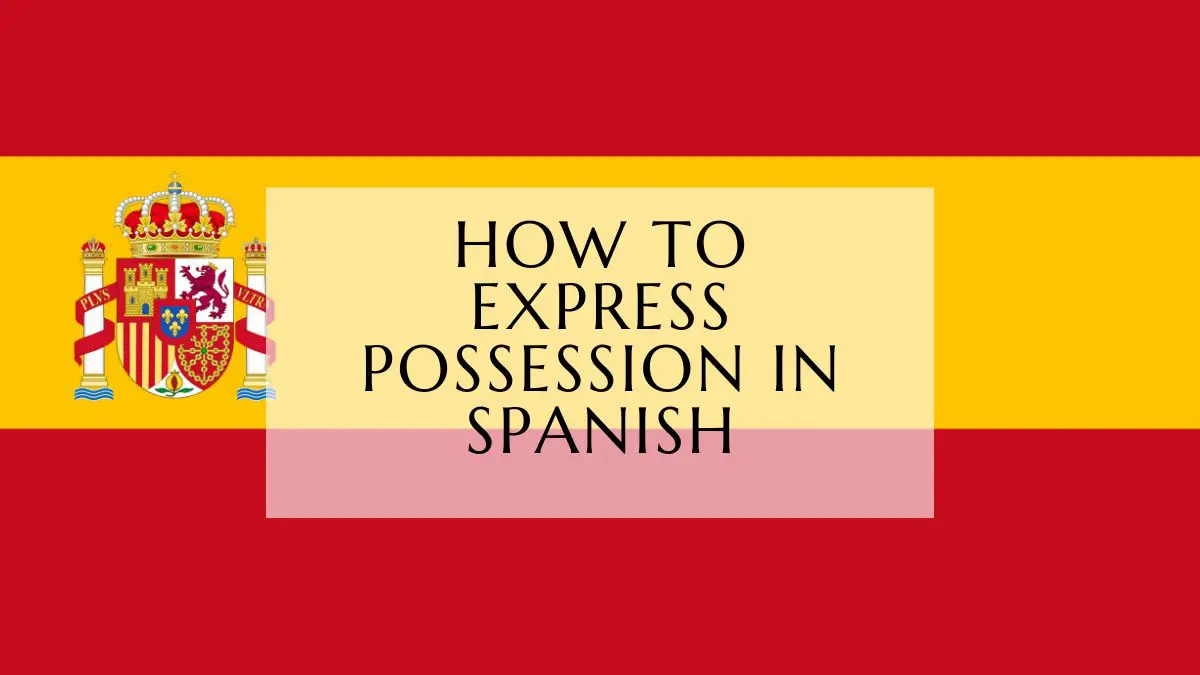In this lesson, we will talk about the possession in Spanish, how to express it and how to avoid the confusion, followed by examples.

Possessive Adjectives In Spanish
Possessive adjectives are used to indicate to whom or to what a thing/person belongs, and they always come before the owned:
Mi libro – my book
Every personal pronoun has its matching possessive adjective, and the selection of the adjective depends on the gender of the “owned” thing/person, and they must agree in gender and number
| Personal Pronouns | Possessive Adjectives (Masc) | Possessive Adjectives (Fem) | English |
| Yo | mi | mi | My |
| Tú | tu | tu | Your (singular) |
| Él | su | su | His |
| Ella | su | su | Hers |
| Nosotros | nuestro | nuestra | Our |
| Vosotros | vuestro | vuestra | Your (plural) |
| Ellos | su | su | Their |
| Ellas | su | su | Their (feminine) |
Note: to get the plural form, add “s“: mi, mis
Mis libros – my books
If you take a look at the table, you would notice that it’s a bit confusing regarding the “su” thing, try to translate this into English: Su libro
Is it his, hers, its, your or their?
To avoid confusion where it is not clear you can use “de + the matching personal pronoun”
Example: their book – el libro de ellos
Note: you can practice what you’ve learned here, and learn how to pronounce each of the words in our Memrise course here, don’t know how to use the platform or sign up? we’ve got you covered in this easy-to-follow tutorial here.
Possessive Pronouns In Spanish
We use the possessive pronouns to avoid repetition: este libro no es mi libro -> este no es el mío
Every possessive adjective has its equivalent pronoun
| Yo > mi > el mío / la mía | mine |
| Tú > tu > el tuyo / la tuya | yours |
| Él/ ella > su > el suyo / la suya | his, hers, its |
| Nosotros > nuestro / nuestra > el nuestro / la nuestra | ours |
| Vosotros > vuestro / vuestra > el vuestro / la vuestra | yours |
| Ellos / ellas > su > el suyo / la suya | theirs |
And the plural form:
| los míos / las mías | mine |
| los tuyos / las tuyas | yours |
| los suyos / las suyas | his, hers, its |
| los nuestros / las nuestras | ours |
| los vuestros / las vuestras | yours |
| los suyos / las suyas | theirs |

That was today’s lesson about the possession in Spanish
Spanish Possession Study Guide
Questions
- What is the primary function of possessive adjectives in Spanish? Provide an example.
- Explain how gender and number affect the selection of possessive adjectives in Spanish. Give an example.
- What strategy can be used to avoid ambiguity when using the possessive adjective “su”? Illustrate with an example.
- What is the main purpose of using possessive pronouns in Spanish?
- Provide the possessive pronoun equivalent for the possessive adjective “nuestro.”
- How do you form the plural of Spanish possessive pronouns? Give two examples.
- Translate the following phrase into Spanish using a possessive adjective: “My house.”
- Translate the following phrase into Spanish using a possessive pronoun: “Yours (feminine, plural).
- What is the difference in meaning between “mi libro” and “el mío”?
- When would you use “el libro de ella” instead of “su libro”?
Short Answer Key
- Possessive adjectives indicate who or what something belongs to and come before the noun. Example: “Mi gato” (My cat).
- Possessive adjectives must agree in gender and number with the noun they modify. Example: “Nuestra casa” (Our house – feminine, singular) vs. “Nuestros libros” (Our books – masculine, plural).
- To clarify the meaning of “su,” use “de + [personal pronoun].” Example: “El libro de ellos” (Their book) instead of “Su libro.”
- Possessive pronouns replace possessive adjectives and the noun to avoid repetition.
- “El nuestro” (masculine) / “La nuestra” (feminine).
- Add “s” to the singular form. Examples: “El mío” becomes “Los míos,” “La tuya” becomes “Las tuyas.”
- “Mi casa.”
- “Las tuyas.”
- “Mi libro” means “my book” and emphasizes the possession. “El mío” means “mine” and replaces the noun “libro” to avoid repetition.
- Use “el libro de ella” (the book of hers) to clarify possession when “su libro” (his/her/its/your book) could be ambiguous.
Glossary of Key Terms
Possessive Adjective: A word placed before a noun to indicate ownership (e.g., mi, tu, su, nuestro).
Possessive Pronoun: A word that replaces a possessive adjective and noun to avoid repetition (e.g., el mío, la tuya, los nuestros).
Gender Agreement: Matching the grammatical gender (masculine/feminine) of nouns and related words (e.g., adjectives, possessive adjectives) in a sentence.
Number Agreement: Matching the grammatical number (singular/plural) of nouns and related words (e.g., adjectives, possessive adjectives) in a sentence.
Happy learning
Oualid Cheddadi is the founder of Lingualid, a platform that inspires independent language learners worldwide, regardless of the language they are learning. The name “Lingualid” is derived from the Portuguese word for “language,” “língua,” and the last three letters of Oualid’s name, “Lid.”



